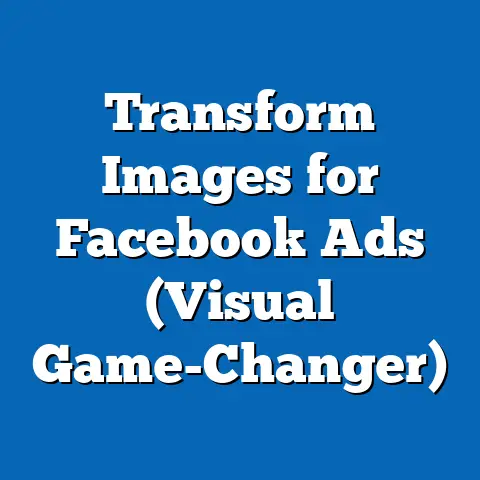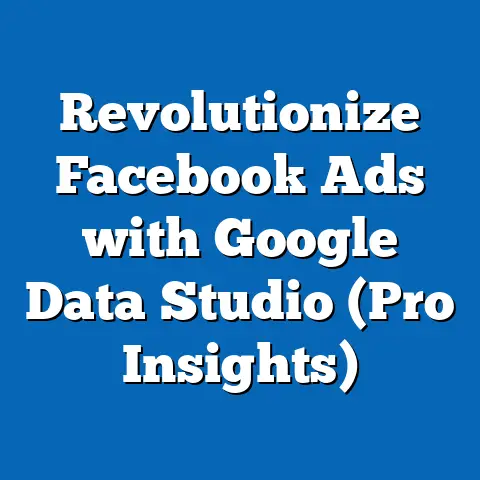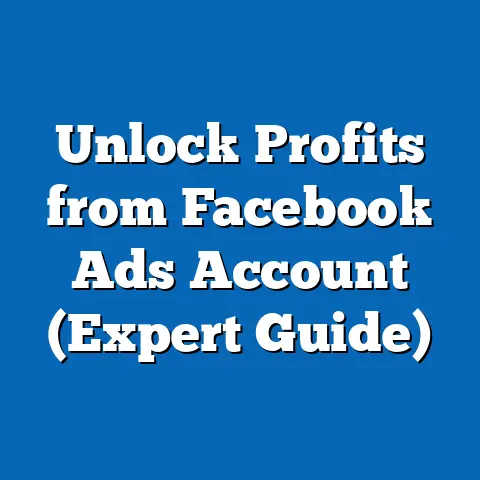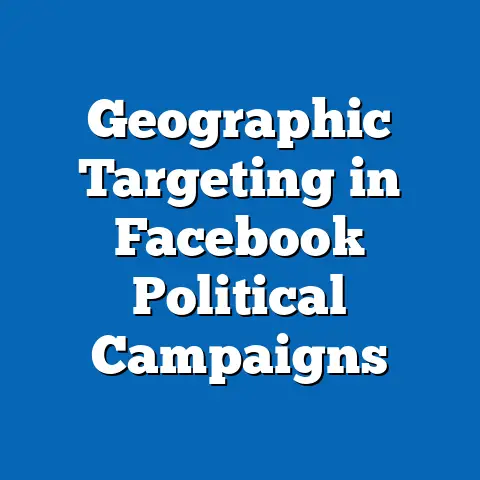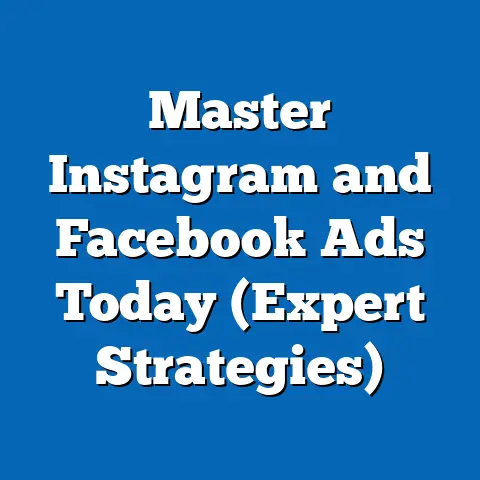Boost Walmart Facebook Ads (Proven Strategies Inside)
As a digital marketing specialist, I’ve seen firsthand how the advertising landscape has evolved. Today, it’s not enough to simply throw an ad out there and hope it sticks. To truly connect with your audience, you need to blend styles, weaving together storytelling, visual appeal, and emotional connection into a compelling narrative. This is especially crucial for a retail giant like Walmart, which has a unique position in the market and a diverse customer base. In this article, I’ll share proven strategies to boost Walmart’s Facebook ads, helping them reach the right people with the right message, ultimately driving sales and brand engagement.
Section 1: Understanding Walmart’s Brand Identity
Before diving into the nitty-gritty of Facebook ads, it’s essential to understand the core of Walmart: its brand identity. This understanding will inform every aspect of your advertising strategy, ensuring your ads resonate with your target audience and reinforce Walmart’s values.
Defining Walmart’s Brand Identity
Walmart’s mission has always been to save people money so they can live better. This simple yet powerful statement encapsulates the brand’s core values: affordability, accessibility, and convenience. Walmart positions itself as a place where everyone can find what they need at a price they can afford.
From my perspective, Walmart has successfully cultivated an image of being a down-to-earth, community-focused retailer. They often highlight their commitment to supporting local businesses and providing opportunities for their employees. This image is critical for building trust and loyalty with their customer base.
Analyzing Walmart’s Target Audience
Walmart’s customer base is incredibly diverse, spanning across different demographics, income levels, and geographic locations. However, when it comes to Facebook, we need to narrow our focus to those who actively engage with Walmart online.
- Demographics: Primarily, Walmart’s Facebook audience consists of adults aged 25-54, with a slight skew towards women. These are often parents, budget-conscious shoppers, and individuals looking for convenience.
- Interests: Common interests include family activities, cooking, home improvement, and saving money. They are likely to follow pages related to parenting, DIY projects, and budget-friendly recipes.
- Online Behaviors: They are active on Facebook, engaging with posts, sharing deals, and participating in online communities. They often use Facebook to research products, compare prices, and read reviews.
Understanding these nuances is crucial for tailoring your Facebook ads to resonate with this specific audience.
Exploring Walmart’s Unique Selling Proposition (USP)
What sets Walmart apart from its competitors? It’s not just about low prices; it’s about the overall value proposition. Walmart offers a wide range of products under one roof, making it a one-stop shop for many customers.
- Affordability: Walmart is known for its everyday low prices, which is a major draw for budget-conscious shoppers.
- Convenience: With thousands of stores nationwide and a robust online presence, Walmart offers unparalleled convenience.
- Variety: From groceries to electronics to clothing, Walmart has a vast selection of products to meet diverse needs.
In my experience, highlighting these USPs in your Facebook ads can be incredibly effective. Focus on the savings, the convenience, and the variety that Walmart offers to attract the right customers.
Key Takeaway: Understanding Walmart’s brand identity, target audience, and USP is the foundation for creating effective Facebook ads. By aligning your messaging and visuals with these core elements, you can ensure your ads resonate with your target audience and drive results.
Section 2: The Importance of Facebook Advertising for Walmart
In today’s digital age, Facebook is more than just a social media platform; it’s a powerful advertising tool. For a company like Walmart, leveraging Facebook’s reach and targeting capabilities is crucial for staying competitive and connecting with customers.
Discussing the Relevance of Facebook as an Advertising Platform for Walmart
Facebook boasts billions of active users worldwide, making it one of the largest and most diverse advertising platforms available. According to recent statistics, Facebook users spend an average of nearly 20 hours per month on the platform. This presents a massive opportunity for Walmart to reach potential customers where they are already spending their time.
Moreover, Facebook’s advertising tools are constantly evolving, offering new and innovative ways to engage with audiences. From video ads to interactive experiences, Facebook provides a wide range of options for showcasing Walmart’s products and services.
Exploring the Benefits of Targeted Advertising on Facebook
One of the biggest advantages of Facebook advertising is its ability to target specific customer segments based on demographics, interests, and behaviors. This means Walmart can reach the right people with the right message, maximizing the effectiveness of their ad campaigns.
For example, Walmart can target ads to parents in a specific geographic area who are interested in baby products. Or, they can target ads to homeowners who are looking for home improvement supplies. The possibilities are endless.
In my experience, targeted advertising on Facebook can significantly improve conversion rates and ROI compared to traditional advertising methods.
Analyzing Case Studies of Successful Walmart Facebook Ad Campaigns
To illustrate the power of Facebook advertising, let’s look at some examples of successful Walmart campaigns:
- Holiday Campaigns: Walmart has successfully used Facebook to promote their holiday sales events. By creating visually appealing ads that highlight their best deals, they have driven significant traffic to their stores and website.
- Back-to-School Campaigns: Walmart has also used Facebook to target parents with ads for school supplies, clothing, and other back-to-school essentials. These campaigns often feature user-generated content and testimonials, which adds credibility and authenticity.
- Grocery Delivery Campaigns: With the rise of online grocery delivery, Walmart has used Facebook to promote their grocery delivery service. These ads often highlight the convenience and affordability of ordering groceries online, appealing to busy parents and individuals.
These case studies demonstrate the versatility of Facebook advertising and its potential to drive sales and engagement for Walmart.
Key Takeaway: Facebook is a powerful advertising platform that offers unparalleled reach and targeting capabilities. By leveraging these tools, Walmart can effectively connect with its target audience, drive sales, and build brand loyalty.
Section 3: Proven Strategies for Creating Effective Walmart Facebook Ads
Now that we understand the importance of Facebook advertising for Walmart, let’s dive into the specific strategies you can use to create effective ad campaigns. These strategies are based on my experience and industry best practices, and they are designed to help you maximize your ROI.
3.1 Crafting Compelling Ad Copy
The ad copy is the text that accompanies your visual, and it plays a crucial role in capturing attention and driving clicks. Here are some techniques for writing persuasive ad copy that aligns with Walmart’s brand voice:
- Keep it Concise: People scroll quickly on Facebook, so you need to get your message across in a few words.
- Highlight the Benefits: Focus on what the customer will gain by clicking on your ad. Will they save money? Will they find a convenient solution to their problem?
- Use Strong Verbs: Verbs like “discover,” “save,” and “get” are more compelling than passive verbs.
- Speak to Your Target Audience: Use language that resonates with the specific customer segment you are targeting.
- Include a Clear Call-to-Action (CTA): Tell people exactly what you want them to do, such as “Shop Now,” “Learn More,” or “Get a Free Quote.”
For example, instead of saying “Walmart has great deals,” you could say “Save big on back-to-school supplies at Walmart. Shop Now!”
3.2 Utilizing Eye-Catching Visuals
Visuals are the first thing people see when they scroll through their Facebook feed, so it’s essential to use high-quality images and videos that grab attention.
- Use High-Resolution Images: Avoid blurry or pixelated images.
- Showcase Your Products: Use images that clearly display your products in an appealing way.
- Use Videos to Tell a Story: Videos are more engaging than static images and can be used to showcase your products in action.
- Reflect Walmart’s Brand Identity: Use colors, fonts, and imagery that align with Walmart’s overall brand aesthetic.
- Optimize for Mobile: Most Facebook users access the platform on their mobile devices, so make sure your visuals look good on small screens.
From my experience, video ads tend to perform better than static image ads, especially when they tell a compelling story or showcase the benefits of your products.
3.3 Implementing A/B Testing
A/B testing, also known as split testing, is the process of comparing two versions of an ad to see which one performs better. This is a crucial step in optimizing your Facebook ads and maximizing your ROI.
- Create Two Versions of Your Ad: Change one element at a time, such as the headline, the image, or the CTA.
- Run Both Ads Simultaneously: Make sure both ads are shown to the same target audience.
- Track the Results: Monitor the click-through rates, conversion rates, and other relevant metrics.
- Analyze the Data: Determine which version of the ad performed better and why.
- Implement the Winning Version: Use the winning version of the ad in your future campaigns.
For example, you could A/B test two different headlines to see which one generates more clicks. Or, you could A/B test two different images to see which one is more visually appealing.
3.4 Leveraging Customer Testimonials and User-Generated Content
Social proof is a powerful tool for building trust and credibility with your audience. By featuring customer testimonials and user-generated content in your ads, you can show potential customers that other people have had positive experiences with Walmart.
- Encourage Customers to Leave Reviews: Ask your customers to leave reviews on your website, Facebook page, or other online platforms.
- Feature Positive Reviews in Your Ads: Highlight positive reviews in your ad copy or visuals.
- Use User-Generated Content: Ask customers to share photos or videos of themselves using your products.
- Get Permission: Always get permission from customers before using their testimonials or content in your ads.
In my experience, ads that feature customer testimonials and user-generated content tend to perform better than ads that are purely promotional.
3.5 Integrating Seasonal and Promotional Campaigns
Aligning your ads with seasonal events, holidays, and Walmart-specific promotions is a great way to engage customers and drive sales.
Key Takeaway: Creating effective Walmart Facebook ads requires a combination of compelling ad copy, eye-catching visuals, A/B testing, social proof, and seasonal promotions. By implementing these strategies, you can maximize your ROI and drive significant results.
Section 4: Measuring Success and Analyzing Performance
Creating great ads is only half the battle. The other half is measuring their performance and using that data to make informed decisions about future campaigns. This section will cover the key metrics to track and how to use Facebook Ads Manager to analyze your results.
Discussing the Key Metrics to Track the Success of Walmart Facebook Ads
There are several key metrics you should track to measure the success of your Walmart Facebook ads:
- Click-Through Rate (CTR): This is the percentage of people who see your ad and click on it. A high CTR indicates that your ad is relevant and engaging to your target audience.
- Conversion Rate: This is the percentage of people who click on your ad and then complete a desired action, such as making a purchase or signing up for a newsletter. A high conversion rate indicates that your ad is effectively driving results.
- Cost Per Click (CPC): This is the amount you pay each time someone clicks on your ad. A low CPC indicates that your ad is cost-effective.
- Cost Per Acquisition (CPA): This is the amount you pay for each desired action, such as a purchase or a sign-up. A low CPA indicates that your ad is effectively driving conversions at a reasonable cost.
- Engagement Metrics: These include likes, comments, shares, and other interactions with your ad. High engagement metrics indicate that your ad is resonating with your audience.
- Return on Ad Spend (ROAS): This is the amount of revenue you generate for every dollar you spend on advertising. A high ROAS indicates that your ad campaign is profitable.
These metrics will give you a comprehensive view of how your ads are performing and help you identify areas for improvement.
Explaining How to Use Facebook Ads Manager to Analyze Ad Performance and Make Data-Driven Decisions
Facebook Ads Manager is a powerful tool that provides detailed data on the performance of your ad campaigns. Here’s how to use it to analyze your results:
- Access Facebook Ads Manager: Log in to your Facebook account and navigate to Ads Manager.
- Select Your Ad Campaign: Choose the ad campaign you want to analyze.
- View the Performance Data: See the key metrics for your ad campaign, such as CTR, conversion rate, CPC, and CPA.
- Analyze the Data: Look for trends and patterns in the data. Which ads are performing well? Which ads are underperforming?
- Make Data-Driven Decisions: Use the data to make informed decisions about how to optimize your ad campaigns. For example, you might decide to pause underperforming ads, adjust your targeting, or change your ad copy.
From my experience, regularly monitoring your ad performance and making data-driven decisions is crucial for maximizing your ROI.
Describing How to Set Benchmarks and Goals for Future Campaigns Based on Past Performance Data
Setting benchmarks and goals is essential for tracking your progress and measuring the success of your ad campaigns. Here’s how to set them based on past performance data:
- Review Past Performance Data: Analyze the performance of your previous ad campaigns. What were your average CTR, conversion rate, CPC, and CPA?
- Set Realistic Goals: Based on your past performance data, set realistic goals for your future ad campaigns. For example, you might aim to increase your CTR by 10% or decrease your CPA by 15%.
- Track Your Progress: Regularly monitor your ad performance and compare it to your goals.
- Adjust Your Strategies: If you’re not meeting your goals, adjust your strategies accordingly. For example, you might need to refine your targeting, change your ad copy, or adjust your budget.
By setting benchmarks and goals, you can track your progress and ensure that your ad campaigns are continuously improving.
Key Takeaway: Measuring success and analyzing performance is crucial for optimizing your Walmart Facebook ads and maximizing your ROI. By tracking the key metrics, using Facebook Ads Manager, and setting benchmarks and goals, you can ensure that your ad campaigns are continuously improving.
Section 5: Future Trends in Facebook Advertising
The world of Facebook advertising is constantly evolving, with new trends and technologies emerging all the time. To stay ahead of the curve, Walmart needs to be aware of these trends and how they might impact their advertising strategies.
Exploring Emerging Trends in Facebook Advertising That Walmart Should Be Aware Of
Here are some of the emerging trends in Facebook advertising that Walmart should be aware of:
- Artificial Intelligence (AI): AI is already being used to automate many aspects of Facebook advertising, such as ad targeting and optimization. In the future, AI is likely to play an even bigger role, helping advertisers create more personalized and effective ads.
- Augmented Reality (AR): AR is a technology that overlays digital images and information onto the real world. Facebook is already experimenting with AR ads, which allow users to try on clothes, visualize furniture in their homes, and interact with products in new ways.
- Personalized Advertising: Consumers are increasingly demanding personalized experiences, and Facebook is responding by offering more sophisticated targeting options. In the future, advertisers will be able to create even more personalized ads that are tailored to the individual needs and preferences of each user.
- Video Advertising: Video is becoming increasingly popular on Facebook, and advertisers are responding by creating more video ads. In the future, video ads are likely to become even more interactive and engaging.
- Short-Form Video: The rise of platforms like TikTok and Instagram Reels has made short-form video a dominant force in social media. Facebook is adapting to this trend by prioritizing short-form video content in its algorithm.
These trends represent significant opportunities for Walmart to enhance their Facebook advertising strategies.
Speculating on How These Trends Might Influence Walmart’s Advertising Strategies in the Coming Years
How might these trends influence Walmart’s advertising strategies in the coming years?
- AI-Powered Ad Optimization: Walmart could use AI to automate the process of optimizing their ad campaigns, freeing up their marketing team to focus on more strategic initiatives.
- AR-Enhanced Shopping Experiences: Walmart could use AR ads to allow customers to try on clothes, visualize furniture in their homes, and interact with products in new ways, creating a more engaging and immersive shopping experience.
- Hyper-Personalized Ads: Walmart could use Facebook’s advanced targeting options to create hyper-personalized ads that are tailored to the individual needs and preferences of each customer.
- Engaging Video Content: Walmart could create more engaging video ads that showcase their products in action and tell compelling stories.
- Leveraging Short-Form Video: Walmart can use short-form video ads to showcase quick deals, product demonstrations, and behind-the-scenes glimpses of their operations, capturing the attention of users scrolling through their feeds.
By embracing these trends, Walmart can stay ahead of the curve and continue to deliver effective and engaging advertising experiences to their customers.
Key Takeaway: The future of Facebook advertising is likely to be driven by AI, AR, personalized experiences, and engaging video content. By staying aware of these trends and adapting their strategies accordingly, Walmart can continue to deliver effective and engaging advertising experiences to their customers.
Conclusion
In conclusion, boosting Walmart’s Facebook ads requires a multifaceted approach that blends various styles to create a compelling narrative that resonates with the target audience. As I’ve outlined, understanding Walmart’s brand identity, leveraging Facebook’s targeted advertising capabilities, and implementing proven strategies for creating effective ad copy and visuals are all crucial for success.
Remember, the key takeaways from this article are:
- Understand Walmart’s brand identity and target audience.
- Leverage Facebook’s targeted advertising capabilities.
- Create compelling ad copy and eye-catching visuals.
- Implement A/B testing to optimize your ad campaigns.
- Leverage customer testimonials and user-generated content.
- Integrate seasonal and promotional campaigns.
- Measure success and analyze performance.
- Stay aware of future trends in Facebook advertising.
By utilizing these proven strategies, analyzing performance, and staying ahead of trends, Walmart can significantly boost its presence and sales through Facebook advertising. The future of retail is increasingly digital, and by embracing these strategies, Walmart can ensure that they continue to connect with their customers in meaningful ways and drive long-term success.

